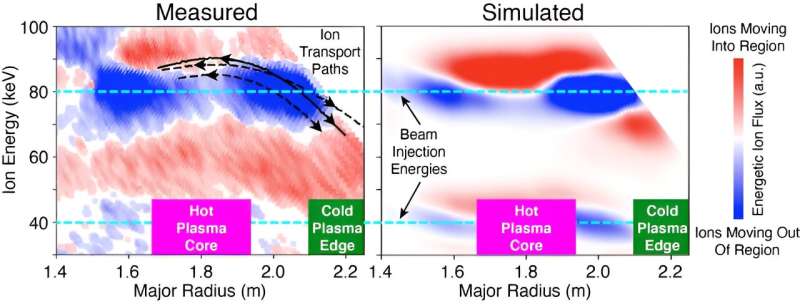This article has been reviewed according to Science X's editorial process and policies. Editors have highlighted the following attributes while ensuring the content's credibility:
fact-checked
trusted source
proofread
Researchers visualize energetic ion flow in fusion devices

In a burning plasma, maintaining confinement of fusion-produced energetic ions is essential to producing energy. These fusion plasmas host a wide array of electromagnetic waves that can push energetic ions out of the plasma.
This reduces the heating of the plasma from fusion reaction products and ends the burning plasma state. Recent measurements at the DIII-D National Fusion Facility provide the first direct observations of energetic ions moving through space and energy in a tokamak.
Researchers combined these measurements with advanced computer models of electromagnetic waves and how they interact with energetic ions. The results provide an improved understanding of the interplay between plasma waves and energetic ions in fusion plasmas.
Plasma physics and fusion research are moving from experimental facilities toward demonstration power plant designs. To make this move a success, researchers need accurate simulations and other tools that predict how power plant designs will perform. Most current facilities do not produce burning plasmas.
However, researchers understand much of the relevant physics and are developing simulations to reproduce observed experimental behavior. The current research made new measurements of energetic ion flow in the DIII-D tokamak. This will accelerate the development of models that account for all relevant wave-ion interaction dynamics. This improved understanding also allows for the application of phase-space engineering.
Researchers can use this process to design new fusion plasma scenarios based on predicted ideal interactions between waves and ions. Notably, these interactions can also impair satellites, so this research may help improve their reliability.
Researchers at the DIII-D National Fusion Facility, a Department of Energy user facility, have used the first measurements from a new diagnostic system, the Imaging Neutral Particle Analyzer (INPA), to observe the flow of energetic ions in a tokamak.
A multi-year effort to conceptualize, design, and build the INPA has now provided the first-ever capability to observe this behavior. After being injected into the tokamak by neutral beams, energetic ions interact with electromagnetic plasma waves and flow in energy and position through the tokamak. Simulations reproduce the observed behavior, thereby demonstrating the accuracy of first-principles models in describing the underlying physics.
Improved understanding of these wave-particle interactions is relevant to the design of fusion power plants and understanding the behavior of plasmas observed in outer space.
The INPA measures the energy of neutral beam-injected energetic ions, which have energies greater than that of the background plasma, across time and spatial position from the hot plasma core to the cold plasma edge, where the ions may be lost.
Coupled with advanced high-performance computing simulations that model both the spectrum of electromagnetic waves and the interactions with energetic ions, these experiments provide the most detailed understanding of the interplay between plasma waves and energetic ions in fusion plasmas.
This improved understanding also allows researchers to apply phase-space engineering, a process in which they design new fusion plasma scenarios based on predicted ideal interactions between waves and ions. These types of interactions occur in outer space.
For example, electromagnetic ion cyclotron (EMIC) waves cause electrons to flow through space and energy. In some instances, electrons have been accelerated such that they cause malfunctions in satellites. Improved understanding of wave-particle resonant interaction processes via fusion plasma research contributes to simulations of outer space plasma, which could improve the reliability of future satellite missions.
The findings are published in the journal Nuclear Fusion.
More information: X.D. Du et al, Visualization of fast ion phase-space flow in plasmas well-below, near and well-above Alfvén eigenmode stability threshold in tokamak, Nuclear Fusion (2023). DOI: 10.1088/1741-4326/acbec5
J. Gonzalez-Martin et al, Modelling the Alfvén eigenmode induced fast-ion flow measured by an imaging neutral particle analyzer, Nuclear Fusion (2022). DOI: 10.1088/1741-4326/ac7406
Provided by US Department of Energy





















